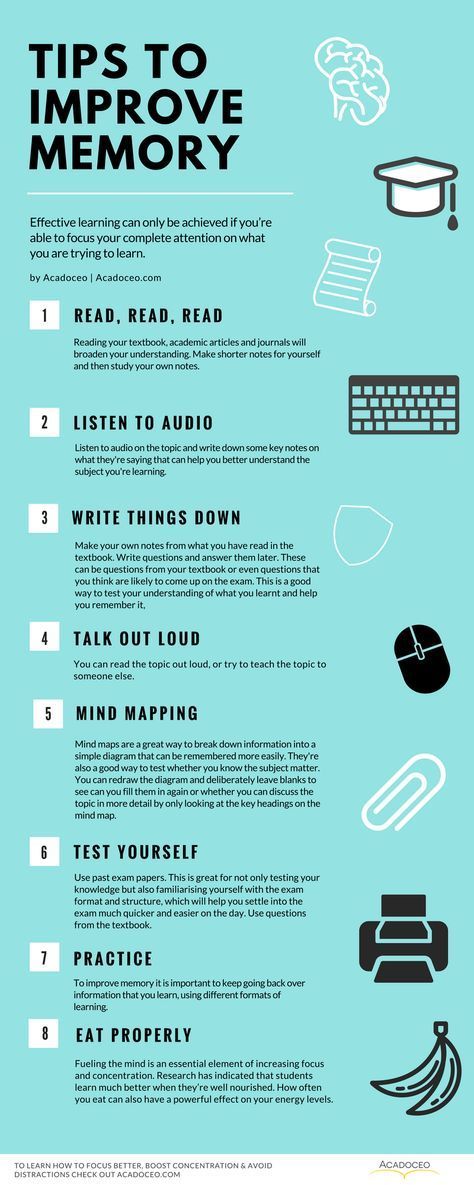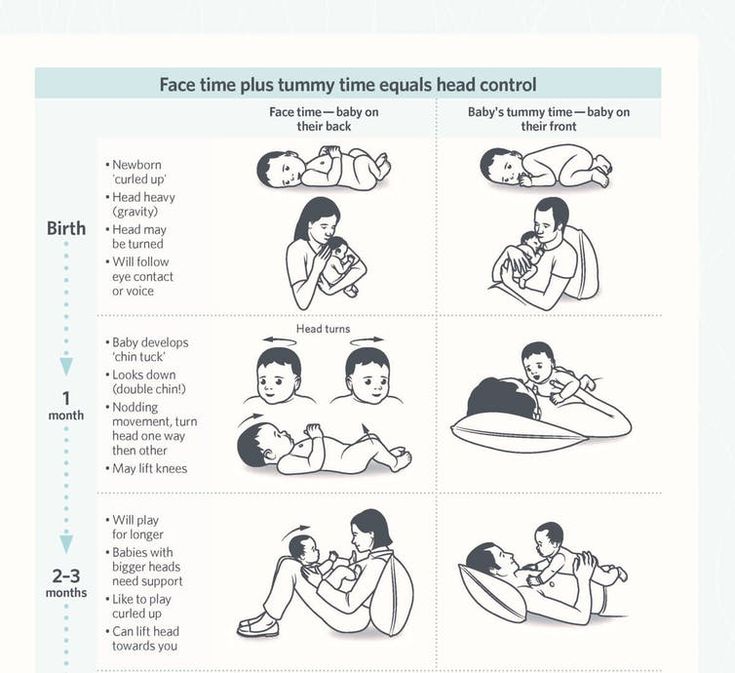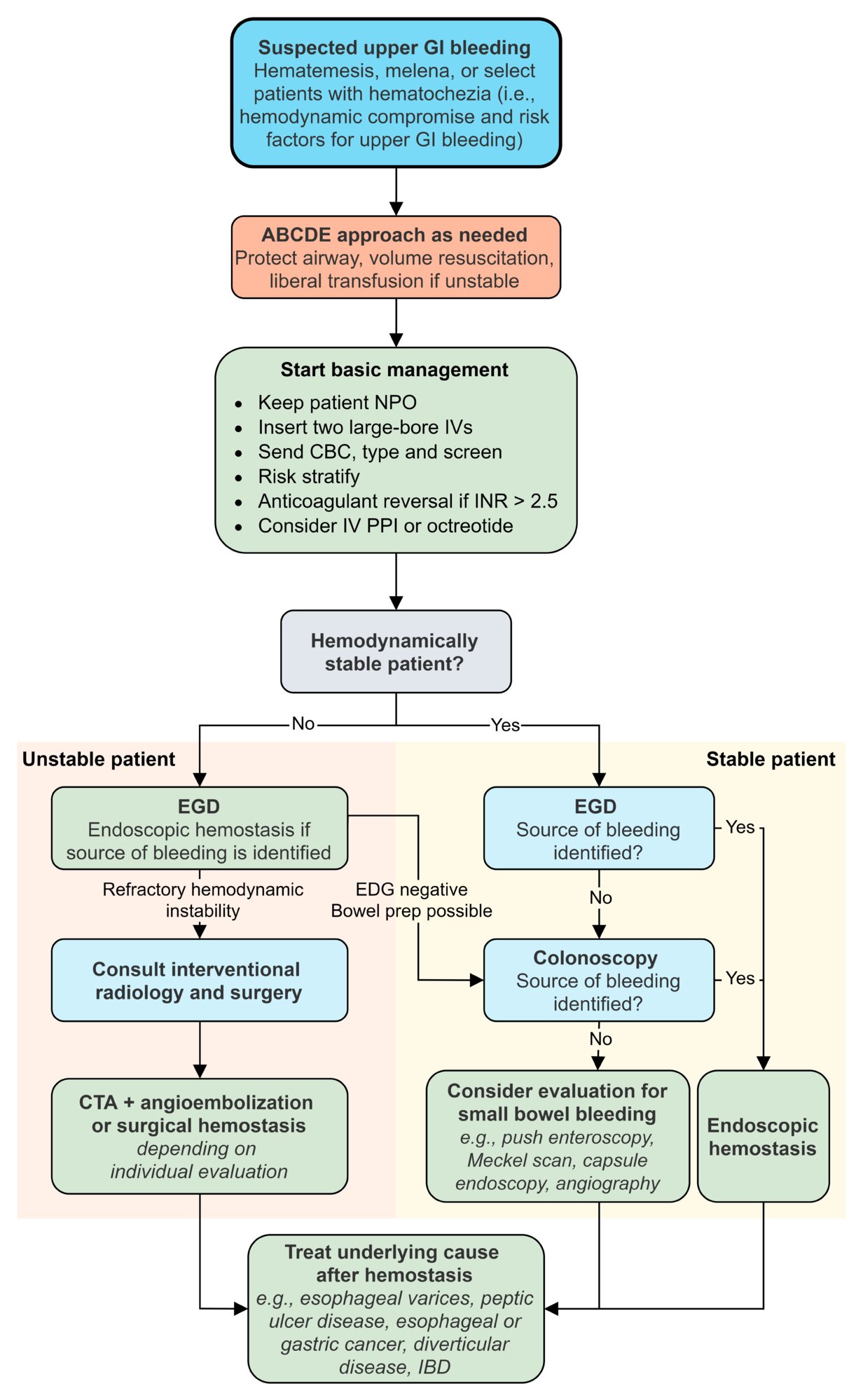Pregnancy and yoga
Yoga in pregnancy: Many poses are safer than once thought
Prenatal yoga is typically gentle, with certain poses modified or avoided depending on the stage of pregnancy. But a new study, published recently in the journal Obstetrics & Gynecology, provides encouraging results that many yoga poses can be safe even during late stages of pregnancy.
Testing the safety of various yoga poses
For the study, the researchers invited 25 women between 35 and 38 weeks of pregnancy to take part in a yoga session. They included women with previous yoga experience as well as those who were new to the practice. All of the women were generally healthy and free of pregnancy-related or other health issues like high blood pressure or gestational diabetes.
The yoga session consisted of 26 poses, including some (such as Happy Baby pose and Corpse pose) that are often avoided during pregnancy. Several poses, including balancing poses like Half Moon, Warrior III, and Tree, were modified by using blocks, chairs, or a wall.
During the session, the researchers monitored each woman’s blood pressure, heart rate, temperature, oxygen levels, and uterine contractions, as well as the fetal heart rate — a measure of a baby’s well-being. All vital signs of both mother and baby were normal during the poses and after the session. There were no falls, injuries, or safety problems.
The researchers also followed up with each participant via email 24 hours after the session. All the women reported feeling safe during the yoga poses. None of them had any problems later with contractions, vaginal bleeding, or reduced movement of the baby. All of the women, except three who described muscle soreness, expressed only positive experiences with the yoga session. The researchers concluded that the 26 different yoga poses — including those that were previously avoided — were safe for both the mothers-to-be and their babies.
Here is a list of the 26 poses from the study. The poses marked with an asterisk (*) were previously thought to be contraindicated during pregnancy.
| 1. Easy pose, Sukhasana 2. Seated forward bend, Paschimottanasana 3. Cat pose, Marjaryasana 4. Cow pose, Bitlasana 5. Mountain pose, Tadasana 6. Warrior I, Virabhadrasana I 7. Standing forward bend, Uttanasana 8. Warrior II, Virabhadrasana II 9. Chair pose, Utkatasana 10. Extended side angle pose, Utthita Parsvakonasana 11. Extended triangle pose, Utthita Trikonasana 12. Warrior III, Virabhadrasana III 13. Upward salute, Urdhva Hastasana | 14. Tree pose, Vrksasana 15. Garland pose, Malasana 16. Eagle pose, Garudasana 17. Downward-facing dog, Adho Mukha Svanasana* 18. Child’s pose, Balasana* 19. Half moon pose, Ardha Chandrasana 20. Bound angle pose, Baddha Konasana 21. Hero pose, Virasana 22. Camel pose, Ustrasana 23. Leg up wall pose, Viparita Karani 24. Happy baby pose, Ananda Balasana* 25. 26. Corpse pose, Savasana* |
This study suggests that yoga can be safe during late pregnancy and adds to the growing scientific evidence that yoga is a helpful, safe tool to reduce stress, anxiety, and depression throughout pregnancy. Over half of all women experience anxiety at some point during pregnancy, and about 13% of pregnant women experience clinical depression. Yoga has been shown to ease stress and anxiety during pregnancy and to reduce levels of the stress hormone cortisol. Several studies of yoga during pregnancy have found it is also effective for reducing depression, particularly when it is started early in the pregnancy and can be combined with standard depression treatment. Yoga can also reduce pain and discomfort, as well as improve overall quality of life during pregnancy.
Prenatal yoga is particularly effective as part of an integrated approach that includes breathing exercises, meditation, and deep relaxation.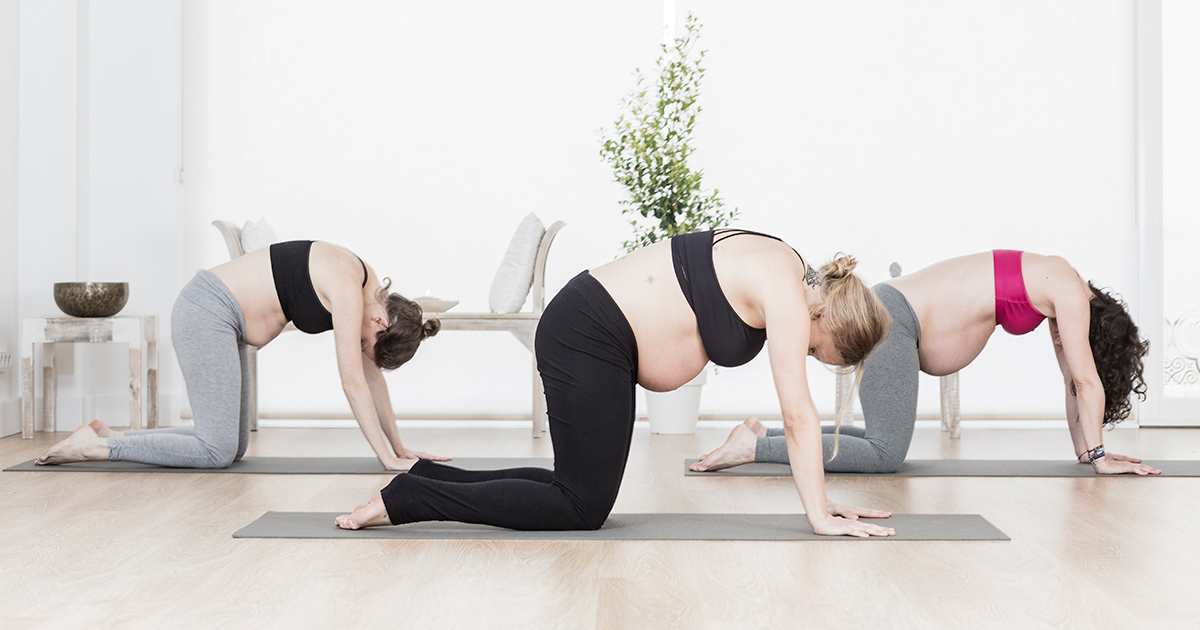
How to make the most of yoga during pregnancy
Moms-to-be should focus more on stability and strength, rather than endurance and flexibility. Use modifications, props, or a wall to make each pose well-supported. Pregnancy hormones loosen your muscles and ligaments, which increases the risk for injuries if you push yourself too far in terms of flexibility. This is true even in the first trimester. Another hormone called relaxin, which is at its highest levels in the first trimester and relaxes muscles, tendons, and ligaments, also peaks in the first trimester. This laxity means you can accidentally over-stretch your joints and muscles.
Finally, some forms of yoga done in extreme heat, like Bikram yoga, where the room can be up to 105 degrees Fahrenheit, are not recommended during pregnancy. There are currently no studies that can tell us whether heated yoga is safe for pregnant women. But we do know heated yoga tends to raise core body temperature, which can pose significant risks for both mother and baby.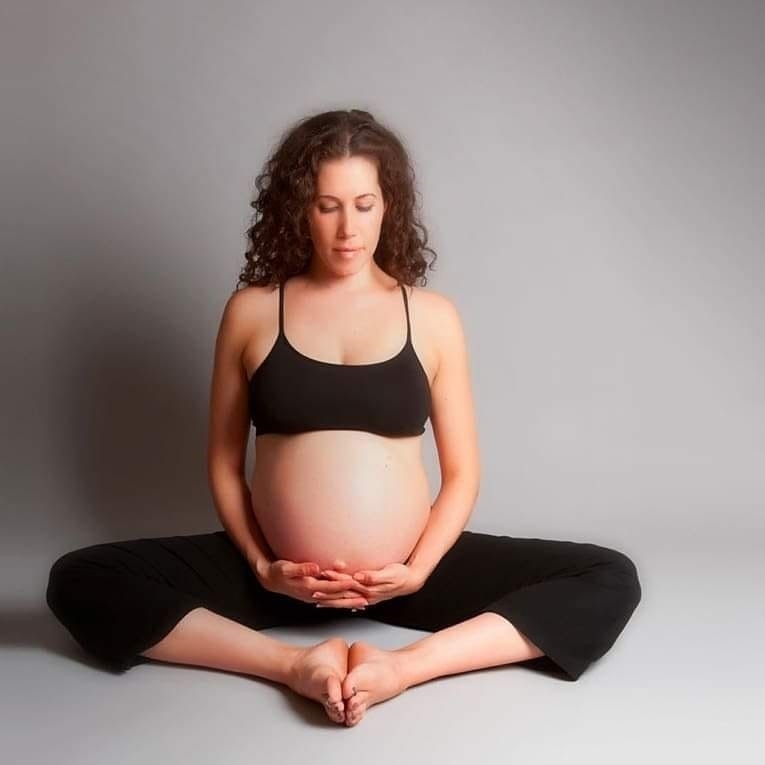 Heat also loosens ligaments further and increases the risk of overheating and dehydration.
Heat also loosens ligaments further and increases the risk of overheating and dehydration.
Yoga offers many benefits during pregnancy. But if you’re pregnant and you want to try yoga, do check with your doctor first.
Health Benefits and Safety Considerations
Written by WebMD Editorial Contributors
In this Article
- What Is Prenatal Yoga?
- Why You Might Want to Try Prenatal Yoga
- Safety Considerations
Practicing prenatal yoga can benefit both mother and child. Prenatal yoga focuses on breathing techniques and gentle stretching. These classes are designed to make you more flexible and prepare you for labor.
If you’re expecting, you may want to consider trying a prenatal yoga class in a studio or at home.
What Is Prenatal Yoga?
Prenatal yoga is a type of yoga designed for pregnant women. Yoga is intended to create a balance between emotional, mental, physical, and spiritual dimensions. Prenatal yoga is about helping you prepare for childbirth by relaxing the body and focusing on safe techniques and poses in all stages of pregnancy.
Yoga can improve your physical and psychological health — and not just for the duration of your pregnancy. If you didn't practice yoga before pregnancy, it's best to talk to your doctor before starting any prenatal yoga classes.
Why You Might Want to Try Prenatal Yoga
It's good for you and your baby to get at least 30 minutes of movement each day. You don't need to do extensive workouts to see the benefits of exercise. Prenatal yoga is a low-impact fitness routine that can help improve your mood and sleep, increase your strength and flexibility, and decrease lower back pain and other common symptoms of pregnancy.
More benefits of doing prenatal yoga include:
Reduces stress and symptoms of depression and anxiety. The combination of intentional movement and structured breathing can help alleviate symptoms of depression. Breathing in slow, rhythmic breaths activates the nervous system and blocks cortisol, which, in high amounts, has been linked to depression.
Improves blood flow. The stretching and movements in yoga help increase blood flow to your heart. Improved blood flow means more oxygen-rich blood is going to your baby. This keeps your baby on track for healthy development.
Betters your labor experience. Starting prenatal yoga in any trimester can help you better relax and stay positive once you go into labor. Meditation and breathing exercises have been shown to reduce pain and anxiety during labor. Being confident and building your coping abilities will also help you have a less painful labor experience.
Helps you build a support system. Prenatal yoga classes can also help your social life by connecting with other expectant moms. A strong support system makes childbirth and postpartum easier. Anxiety about the delivery process can make labor worse. Being able to talk through your experience and hear others' stories can be comforting.
Yoga During Each Trimester
The further along you are in your pregnancy, the less intense your workouts should be.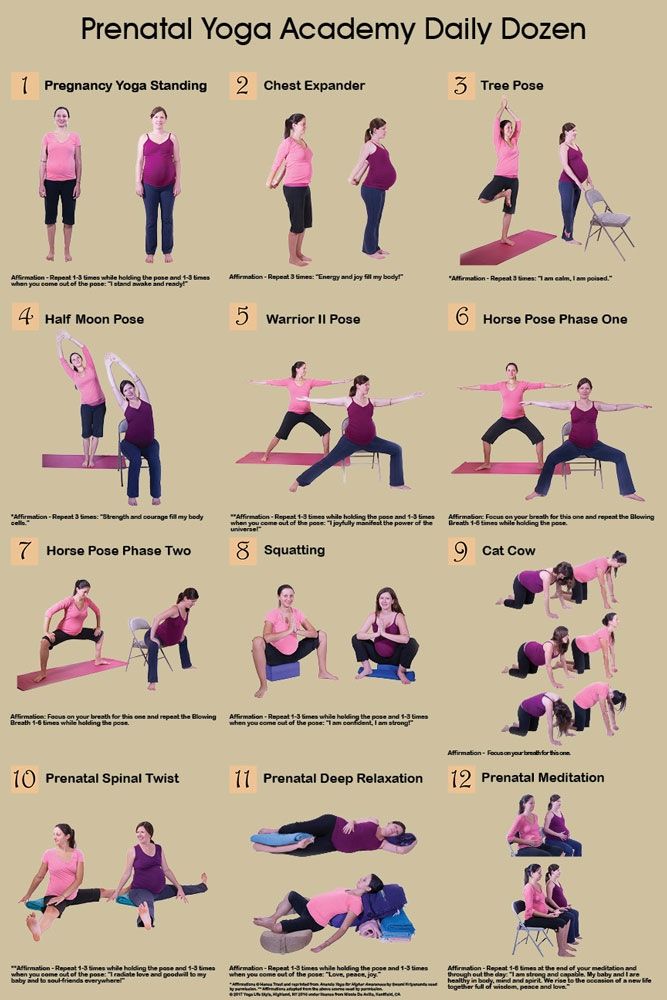
The first trimester. You may feel fatigued and sick during this trimester. Try to avoid overworking yourself. Doing yoga poses slowly and carefully will prevent you from feeling worse. Yoga can alleviate pregnancy symptoms like nausea and backaches.
The second trimester. At this stage, you’ll want to avoid belly poses and sharp twists. If you've been practicing advanced poses like backbends and inversions — where your feet are above your head — you may want to modify them. Inversions can compress your lungs and cause severe discomfort.
The third trimester. You may feel tired more often and your balance may be off-centered. Yoga during this time should focus on restorative and hip-opening poses. Light stretching will help ease your aches and pains. Avoid lying on your back. Blocks and pillows can help you get into comfortable, safe positions.
Safety Considerations
Movement and exercise are great ways to stay healthy during pregnancy, but pushing yourself too hard can be counterproductive. Certain exercises and poses can be dangerous to you and your baby.
Certain exercises and poses can be dangerous to you and your baby.
There are certain types of yoga to avoid when pregnant. Hot yoga can be dangerous because extreme heat can cause neural tube defects. Twisting and bending should also be avoided. These movements can put you off balance and increase your risk of falling. Poses that put a lot of pressure on your abdomen can harm your baby as well.
Even if you exercised before pregnancy, you should still talk to your doctor before beginning any prenatal yoga routine. Watch for signs like sharp pain with certain movements, vaginal bleeding, or decreased fetal movement. If a movement or posture doesn't feel good, slowly bring yourself back to a comfortable position.
Yoga for pregnant women in trimesters: what you need to know?
Administrator Reading time 10 minutes
Article content:
The period of bearing a child is the most beautiful and responsible time for a woman. All nine months, the expectant mother must take care not only of her well-being, but also of the health of her baby. Although a pregnant woman feels a kind of discomfort, physical inconvenience, the time of waiting for a baby is a bright and happy period of life. nine0005
All nine months, the expectant mother must take care not only of her well-being, but also of the health of her baby. Although a pregnant woman feels a kind of discomfort, physical inconvenience, the time of waiting for a baby is a bright and happy period of life. nine0005
Doctors recommend that pregnant women do yoga. This is a great way to find physical and mental balance. A woman will learn to feel and her future baby.
Training Tips and Practice Tips
Yoga is a great way to improve your well-being. Asanas (body positions, exercises) will help to avoid health problems.
Before starting classes, a pregnant woman should consult a doctor from the antenatal clinic. If there are no contraindications (uterine hypertonicity, toxicosis), you can safely spread the rug and prepare the body for future stress during childbirth. A pregnant girl should practice yoga under the guidance of a trainer. It is worth telling your doctor about all the details of the classes (postures, body reactions to exercises).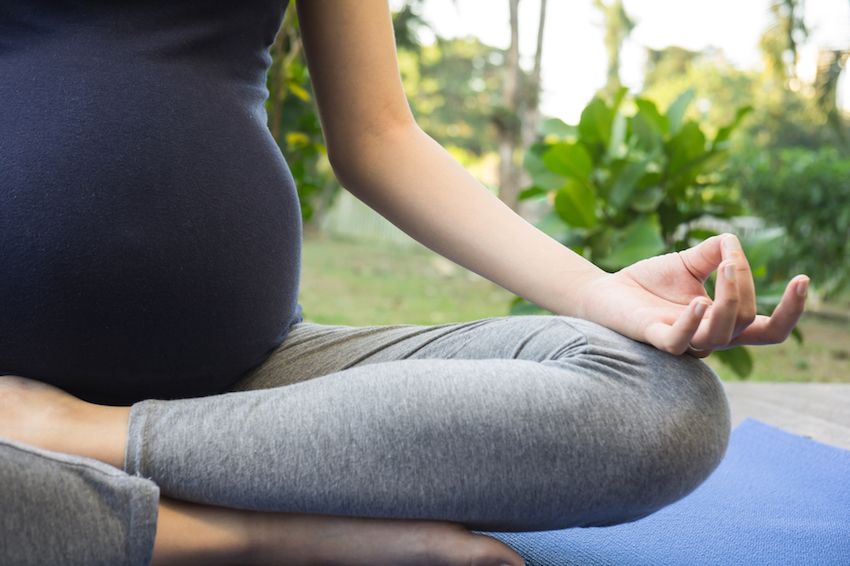 Closer to the date of birth, the load on the body decreases, and the list of acceptable asanas is reduced. nine0005
Closer to the date of birth, the load on the body decreases, and the list of acceptable asanas is reduced. nine0005
Important! A pregnant girl should practice yoga under the guidance of a trainer.
Recommendations.
Yoga comes in many forms. Expectant mothers do yoga for pregnant women. This type of yoga is different from classical exercises, accompanied by less physical activity.
Yoga is both physical and mental preparation. Women train their back muscles, which is very important in late pregnancy. At the same time, they give birth easier, without injuries and ruptures. Meditative techniques have a positive effect on the opening of the lungs, provide a constant supply of oxygen. nine0005
Mood improves after exercise. Exercise can help prevent postpartum depression. Inverted asanas will help the fetus to be placed correctly in the womb.
A feature of yoga for pregnant women is the ability to find balance and comfort in the most difficult poses.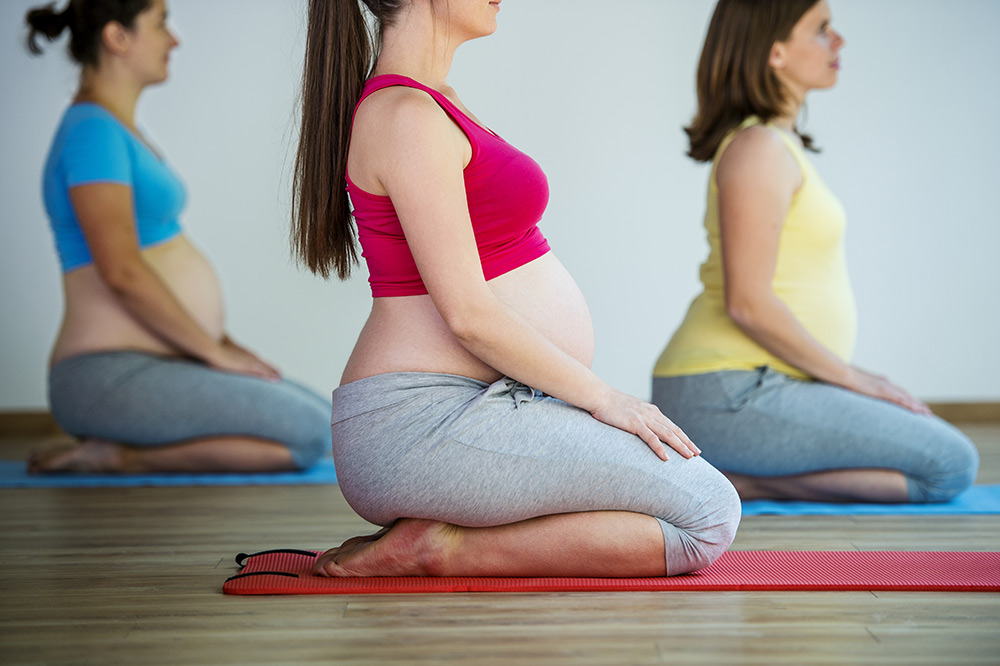 Centuries-old Indian traditions will help you learn how to breathe correctly. This practice will come in handy during fights.
Centuries-old Indian traditions will help you learn how to breathe correctly. This practice will come in handy during fights.
Classes will be aimed at strengthening the spine and joints, because the load on them will increase every day. Back exercises increase blood circulation in the pelvic area. The change of positions is slow and smooth. Aerobics, sudden movements and jumps are absent. nine0005
Experts recommend doing breathing exercises several times a day without the help of an instructor at home. Breathing exercises will prevent hypoxia of the newborn, reduce pain, and become a useful skill during the birth itself.
Forbidden asanas:
- twist;
- forward bends;
- postures with prone position;
- exercises for the press; nine0040 backward bends from a prone position;
- jumping, sudden movements.
A pregnant woman who has been practicing yoga for more than one year should in no case perform complex exercises.
The main task is to help the body adjust to a new way of life.
Features of yoga classes at different stages of pregnancy
Since physical activity is prohibited for pregnant women, it is worth looking for other options for keeping the body in shape. Yoga classes in any trimester will bring the body into tone, protect against stress and emotional disorders. nine0005
Yoga for pregnant women will be a useful pastime. It is useful at any time. On the benefits of this sport, you can watch videos on the Internet. The main condition is the absence of contraindications, otherwise it is better to start classes from the second trimester.
The 1st trimester is associated with an unbalanced emotional state of the pregnant woman. Training will bring positive emotions and pleasure from the time spent in the gym. For this period, the “kitty”, “lotus”, “tree” poses are suitable. Each exercise is performed for 10 seconds. nine0005
The 2nd trimester is the best period of pregnancy. The body is accustomed to its new state. Yoga classes should be directed to strengthening the general physical condition. Instructors recommend avoiding complex strenuous exercises.
Poses for pregnant women:
- asana "kitty" - will strengthen the spine and unload the kidneys;
- "hero" pose (virasana) - improves posture and strengthens the back muscles;
- pose "butterfly" (konasana) - will increase blood circulation in the pelvic area, stimulates the bladder, will benefit the uterus; nine0041
- pose "mountains" (tadasana) - contributes to the enrichment of the body with energy.
The 3rd trimester is the hardest time. A round belly does not allow you to move easily and quickly. Instructors make the main emphasis on a set of exercises that develop breathing (pranayama). A pregnant woman should imagine how the inhaled air flows throughout the body, enriches it with oxygen, improves well-being.
Yoga is a useful occupation for a pregnant woman.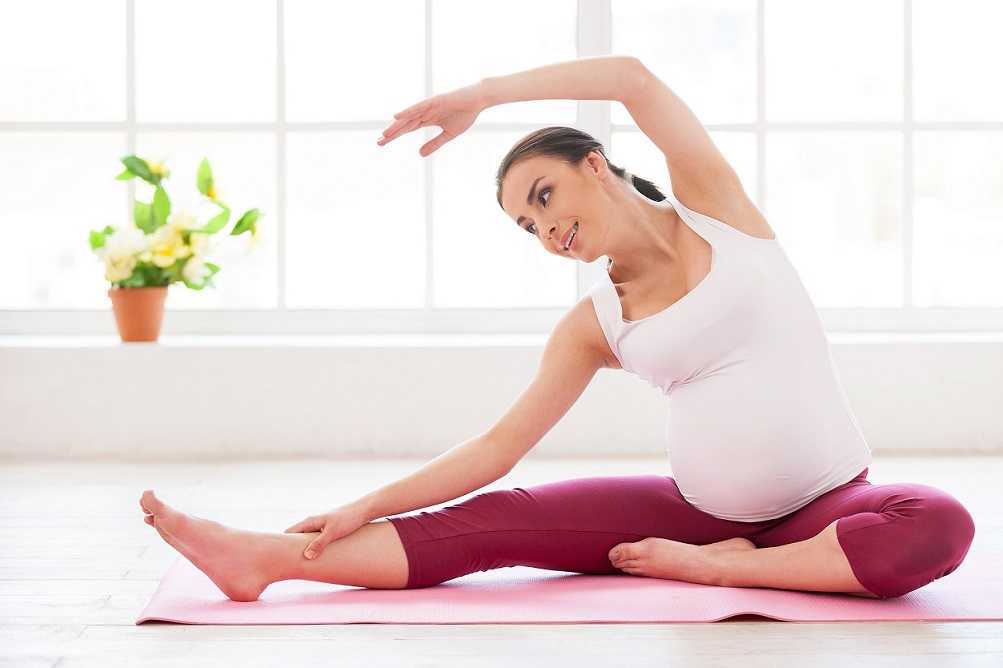 For training to be successful, you must follow the advice of doctors and instructors. nine0005
For training to be successful, you must follow the advice of doctors and instructors. nine0005
pregnancy group training yoga workouts
is it possible to do yoga while pregnant?
Pregnancy is a very exciting and responsible period in a woman's life. At this time, it is especially important for the expectant mother to monitor her physical and emotional health and, of course, prepare her body for childbirth as far as possible. Doctors do not advise women to completely give up exercise during pregnancy, but preference should be given to calm types of fitness, such as yoga. nine0093
Can pregnant women practice yoga?
A few years ago, it was believed that yoga is a complex and even mysterious practice, which consists entirely of “braided” postures, headstands or one-arm stands - in a word, such exercises that are difficult to perform without thorough preparation. However, today, when many types of yoga are practiced not only in special centers, but also in sports clubs, it is known that there are different levels of difficulty - from a hatha yoga course for beginners to an intensive Ashtanga or Bikram yoga course for the most advanced. Not so long ago, they began to offer special practices for expectant mothers. nine0005
But isn't it bad for pregnant women to practice yoga? If you approach classes responsibly, correctly calculate the load and be careful, then it is not only not harmful, but also very useful, which we will discuss in more detail below. However, if a pregnant woman wants to start (or continue) practicing yoga, she should definitely consult a doctor.
This is important Yoga is contraindicated in severe toxicosis or preeclampsia, uterine hypertonicity, threatened miscarriage, high blood pressure, polyhydramnios, abnormal position of the cervix, isthmic-cervical insufficiency, placenta previa. Even in the absence of contraindications, permission to exercise must be issued by the supervising physician. nine0005
Why is yoga useful for expectant mothers?
With all the limitations, the practice of yoga helps a lot in preparing for childbirth, not only physically, but also morally.
1. During pregnancy, the muscles of the whole body (and especially the abs and back) experience a static load and need timely relaxation, strengthening and stretching, which is facilitated by yoga.
2. The muscles of the pelvis also need to be trained, and many asanas help to “open” the pelvis correctly and make the muscles more elastic. In this case, the risk of injury during childbirth is reduced for both mother and baby. nine0005
3. The correct breathing technique taught during the practice will help with contractions.
4. Performing asanas improves blood circulation, and hence blood exchange between the mother and fetus, is the prevention of vein thrombosis.
5. Gentle physical activity helps to control weight, ensure the saturation of body tissues with oxygen, strengthen the immune system, and improve digestion.
6. Yoga, even "narrowly focused" perinatal, last but not least, is a spiritual practice that teaches self-control, proper relaxation, getting rid of negative thoughts and allows you to find harmony with yourself in this new state.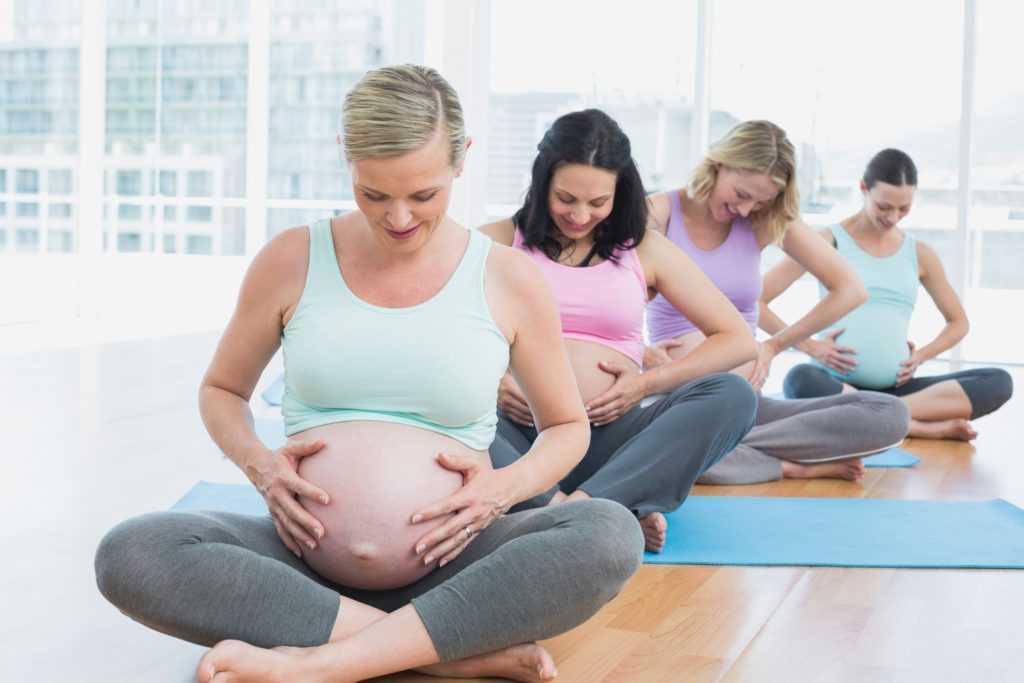 nine0005
nine0005
7. Practitioners say that regular exercise relieves insomnia, headaches, improves mood.
Of course, all the time you need to control your condition, as the pregnancy develops, replace some asanas with others that are easier to perform and useful at a particular stage.
Pregnancy yoga 1st trimester: the path of the "warrior"
In the first 12 weeks of pregnancy, you should try to avoid poses with jumps, deep twists, backbends, inverted poses - their performance can harm the fetus or the expectant mother. Also, you should not practice breathing exercises both with an increase in the rhythm and with a delay in breathing, opting for those that teach you to breathe deeply and evenly. nine0005
Possible asanas:
- Adho mukha svanasana (downward-facing dog) and its second variant (three-legged dog) with one leg up. These asanas help reduce stress on the back muscles.
- Marjariasana (Cat Position) develops the pelvic and back stabilizing muscles, makes the press more elastic (this is important so that the growing belly does not cause discomfort).
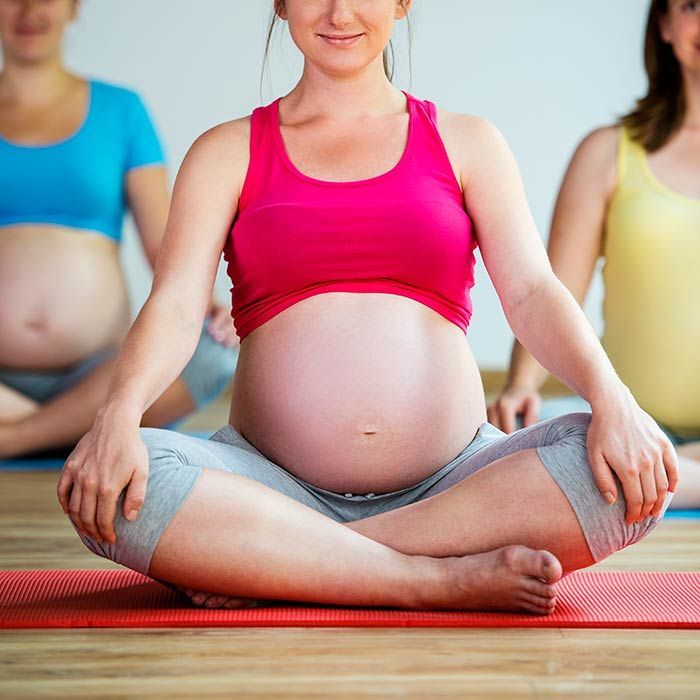 Remember not to bend too much. nine0041
Remember not to bend too much. nine0041 - Virabhadrasana (warrior/hero position) works out the muscles of the whole body, helps with proper concentration.
- Bhadrasana (throne position) is one of those asanas that can be performed throughout pregnancy. It develops pelvic muscles, reduces the load on the spine, has a beneficial effect on the blood supply to the abdominal organs, including blood exchange with the fetus.
Pregnancy yoga 2nd trimester: easy as a butterfly
Starting from the 12th week, it is necessary to exclude asanas on the stomach, as well as those requiring a long stay in the position on the back. It is worth limiting postures with a load on one leg (to avoid the development of varicose veins). But now a woman can perform inverted asanas, of course, with all precautions.
Examples of postures to perform:
- Viparita karani (bent candle position) has a beneficial effect on blood circulation, allows blood to “drain” from the legs, thereby reducing the possibility of swelling, strengthens the muscles of the body.
nine0041
- Supta baddha konasana (butterfly position) . This asana, like bhadrasana, “opens” the pelvis, helps relieve discomfort, a pulling sensation in the lower abdomen. The stand is performed in the prone position, but during pregnancy it is better to place a roller under the head and back in order to be in a half-sitting position.
- Padahastasana (tilt to the feet with a grip) relieves muscle stiffness and static load, strengthens the muscles of the legs, abs, shoulders. No need to try to grab the feet if the stomach no longer allows it - do the exercise to the best of your ability. nine0041
- Tadasana (rock position) is a classic asana that stretches the spine, improves blood circulation, and opens the chest.
Pregnancy yoga 3rd trimester: "tree" will help
The last weeks of pregnancy are a time of intensive preparation for childbirth, so the emphasis should be on asanas that improve the elasticity of the pelvic muscles and help to relax.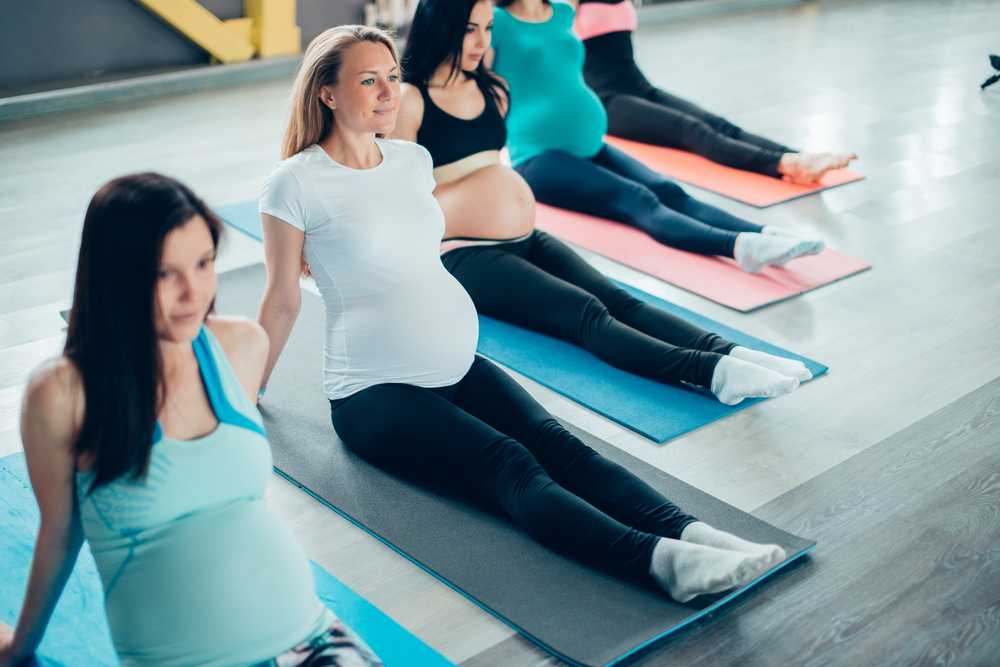 From 32 weeks, more attention should be paid to breathing techniques.
From 32 weeks, more attention should be paid to breathing techniques.
- Vrikshasana (tree position) . This balance asana is actually multifunctional: it makes the inner thigh muscles elastic, helps to straighten the spine, increase lung capacity (which is very important for breathing during childbirth), and improve blood flow in the upper shoulder girdle. It is better to perform this exercise against a wall for support.
- Viparita dandasana (inverted staff position) opens the chest, relieves lumbar pain, strengthens the stabilizing muscles. Since the stance requires a backward bend, it is better to use a bench or special rollers - bolsters for safety. nine0041
- Janu shirshasana (tilt to the knee) . In the last trimester, a woman experiences more and more stress on her legs and therefore. In order to avoid the formation of thrombosis, varicose veins and other unpleasant consequences, it is useful to perform asanas that stretch the muscles of the legs and hips, for example, jana shirshasana.

 Half Lord of the fishes pose, Ardha Matsyendrasana
Half Lord of the fishes pose, Ardha Matsyendrasana

